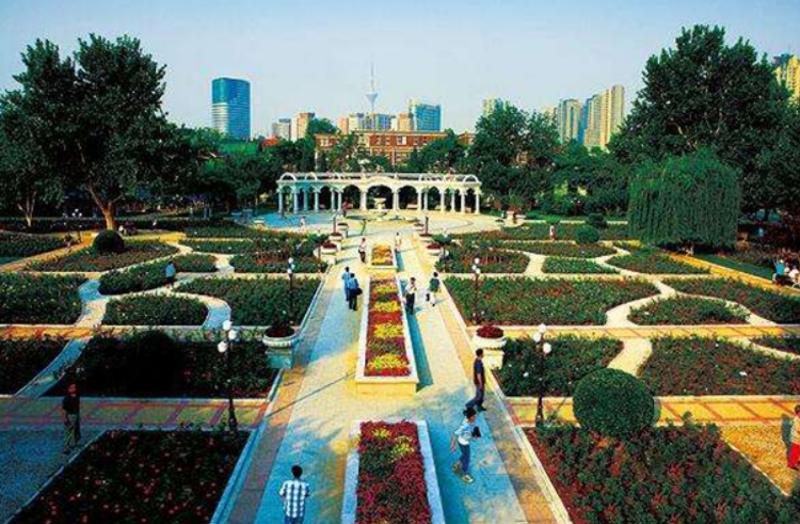Tianjin Fifth Avenue Munan Park
Munan Park, situated in the southern part of Heping District in Tianjin, lies between Munan Road and Dali Road, with Yunnan Road to its east and Rose Hall to its west. The park covers an area of 14,550 square meters.

Reference: Tianjin Wudadao: A Cultural and Historical Tourism Area
Core Area of Five Great Avenues
Munan Park is located in the core area of the Five Great Avenues, covering 1.8 hectares. It is the only specialized botanical park remaining in this region. The design of Munan Park carefully considers the surrounding environment and the characteristics of the architectural group in the area, blending visual aesthetics with cultural ambiance to create a two-level landscape. The park harmonizes with the style, materials, and colors of the 40 buildings around it, as well as with the surrounding environment. Munan Park is an open urban park that combines functionality, aesthetics, and cultural elements with a reasonable layout, clear zoning, and comprehensive facilities.
Design and Landscape
Munan Park adopts an eclectic style, evolving from the British free-form garden to a combination of formal and natural styles. It incorporates Western cultural features, Chinese cultural features, and a blend of both. The Western cultural aspect is evident in the flat garden layout, with a circular center from which multiple paths radiate. At the center is a fountain pool surrounded by square flower beds planted with diverse species. The paths are divided into traffic routes and leisure paths, mostly straight with some curving paths separating the flower beds, reflecting the natural style of British gardens.
The park uses plant landscaping as its main form, integrating roads, stones, water, forests, flowers, and plazas to root the scenery in the environment. By combining clusters of trees, shrubs, and ground cover plants with evergreens and deciduous plants, the park achieves a landscape that is green year-round, blooms in three seasons, and bears fruit in two. The surrounding plants are grouped to create a stark contrast with the expansive rose beds, providing visitors with small ecological spaces for shade and cooling. This achieves the effect of "small areas within a large environment, small environments within a large ecosystem."
Additionally, on the basis of the original 50 rose varieties, the park has introduced excellent domestic and international varieties, now totaling over 180 types. Educational signage has been installed, making it a base for rose cultivation and scientific education in the city.
Human History
Before the liberation of Tianjin, Munan Park was a flower nursery in the British concession.
- 1949: After Tianjin's liberation, the park was repurposed as a nursery, named Munan Road Nursery, using dredged silt from the Hai River.
- 1952: It became a semi-open nursery for cultivating and propagating rose varieties.
- 1964: It was transformed into a greening science research institute, and the Urban Construction Bureau established a nursery there, cultivating many quality fruit tree varieties.
- 1970: The park was opened to the public.
- 1982: It was converted into a park with a small park layout, adding pavilions, corridors, flower stands, garden lamps, seats, and garden ornaments.
- 1995: It was promoted to a municipal first-class park.
- 1998: A renovation was carried out, constructing a 200-square-meter flower exhibition hall displaying over 300 varieties of precious flowers.
- 2009: Another enhancement project was undertaken, adhering to the design concept of "historical context meets modern people." This project further developed the park's function as an urban green space, positioning it as a classic European rose-themed garden in the city center, maintaining the park's characteristic focus on rose variety planting. Now, the park houses over 180 varieties of premium roses with more than 14,000 plants.
Park Features
- Park Area: 14,550 square meters
- Opening Hours: Open all day
Munan Park in Modern Times
Munan Park remains a vital part of the urban landscape in Tianjin, offering a blend of historical charm and modern amenities. Its continuous evolution and commitment to preserving botanical diversity make it a cherished green space for residents and tourists alike.
QA Section
Q1: What makes Munan Park unique compared to other parks in the Five Great Avenues area?
A1: Munan Park is unique because it is the only specialized botanical park remaining in the Five Great Avenues area. It combines functionality, aesthetics, and cultural elements, featuring a blend of Western and Chinese cultural styles. The park houses over 180 varieties of premium roses and serves as a base for rose cultivation and scientific education.
Q2: What significant changes were made to Munan Park during the 2009 enhancement project?
A2: The 2009 enhancement project adhered to the design concept of "historical context meets modern people." It further developed the park's function as an urban green space, positioning it as a classic European rose-themed garden in the city center. The project maintained the park's characteristic focus on rose variety planting and integrated modern elements to harmonize with the overall style of the Five Great Avenues area.